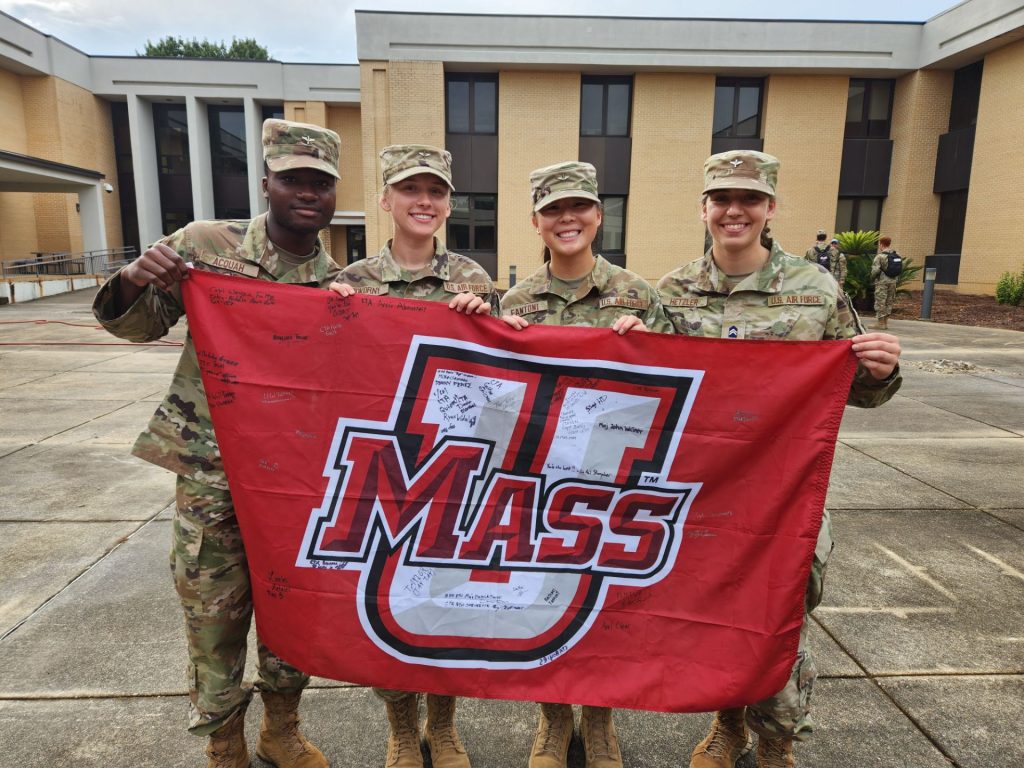
Our Story
The commonwealth of Massachusetts Agricultural College (MAC) was established under the provisions of the 1862 Morrill Land Grant Act of Congress. Students of the pioneer class of 1867 were taught military drill by one of the four professors who made up the academic staff in the first year.
In 1869, regulation drill, infantry skirmishing, and the use of the saber, bayonet, small arms, and artillery were added. Soon, an infantry battalion was organized and led by student officers. The battalion review became a prominent feature of campus celebrations. Instruction during inclement weather took place in College Hall, one of the three buildings built for the pioneer class.
The Corps, established at MAC on 1 October 1918, with 351 enrolled, enjoyed a short existence. War ended on 11 November 1918, and the corps was disbanded by 21 December 1918. There were 1304 “Aggie” men in uniform during W.W. I and 445 held commissions. A table in Memorial Hall bears 51 names of those who made the supreme sacrifice during the war.
The corps of cadets was absorbed into the Reserve Officer Training corps after the war. Horses were shipped in, and cavalry tactics replaced infantry tactics. There was a sportsmen’s interest in drill, country rides, polo, horse shows, and a night ride test held each Spring. The summer camp was a 195 mile cavalry march to Fort Ethan Allen, Vermont, where the cadets, under the supervision of Regular Army Instructors, underwent training in firing, tactics, and associated skills.
On 15 April 1931 Commonwealth legislators changed the name of Massachusetts Agricultural college to Massachusetts State College.
During W.W.II, classes shrank in size and a few courses were canceled. Although College activities were sustained in the same pattern, it was largely a women’s college. By 1944, the total number of students in the regular program had dropped from 1263 (enrolled in 1941) to 725; of these, 600 were women. A portion of this drop, in 1943, resulted from the junior and senior ROTC cadets being sent to Officer Candidate Schools. There were over 2000 State college men and women in the fighting forces of the nation in W.W.II, and the honor roll at Memorial Hall bears 122 names.
Massachusetts State College became the University of Massachusetts in 1947. Cavalry ROTC became Army ROTC, and tanks replaced the horses. Advanced course cadets journeyed to the Armor Center at Fort Knox, Kentucky for their Summer Camp. A force of six tanks were maintained on campus from 1947 to 1963. An Army Air Corps officer was assigned to the instructor group and presented flight training until the U.S. Air Force was formed. Shortly thereafter, the ROTC program was divided and became the Department of Military Science and the Department of Air Science.
From 1964 to 1971, the number of commissions remained relatively stable while the University enrollment was multiplying. In 1968, the anti-military feeling in New England began to mushroom and a significant drop in Freshman enrollment occurred. Overall enrollment in the Department of Air Science reached an all time low of 29 cadets in 1972, with only one cadet in the Freshman class.
On 20 April, 1972, a disruptive five day student occupation of the Army ROTC detachment at Dickinson Hall began. To prevent a confrontation, the University requested that all ROTC classes be canceled during the occupation. The Faculty Senate voted on 27 April 1972 to discontinue academic credit for all courses taught by the divisions of Military and Air Science on the Amherst campus.
Ultimately, in 1973, academic credit was restored to the military departments. Due to its reduced enrollment the Military Science Department was moved to the Campus Police Department building which had once housed the corps’ tanks. Shortly thereafter, Air Force ROTC took the present position on the second floor of Dickinson Hall, sharing the rest of the building with the Campus Police Department.
During the 1990s, the military once again downsized. Air Force ROTC had significant reductions in enrollment, attaining a 20-year low of 30 cadets in September of 1992. It was in 1993 that the Northeast Region Commander, Colonel Richard Shapiro, recommended to University officials that Detachment 370 be closed due to a lack of enrollment. Chancellor Thomas O’Brien expressed his desire for AFROTC to remain on campus. Det 370 was put on probation and was required to attain a quota of 15 commissionees in at least three of the upcoming five years. The AFROTC program recovered dramatically, with 56 cadets enrolled n September of 1994, 71 enrolled in September of 1995, and 65 enrolled in September of 1996.
Since its creation, the AFROTC program at the University of Massachusetts has commissioned close to 1000 officers. Approximately, 25 cadets became generals and many more retired as lieutenant colonels or colonels. The program has undergone many different changes, we look forward to what the future holds for Detachment 370…Strong, Proud, Free!